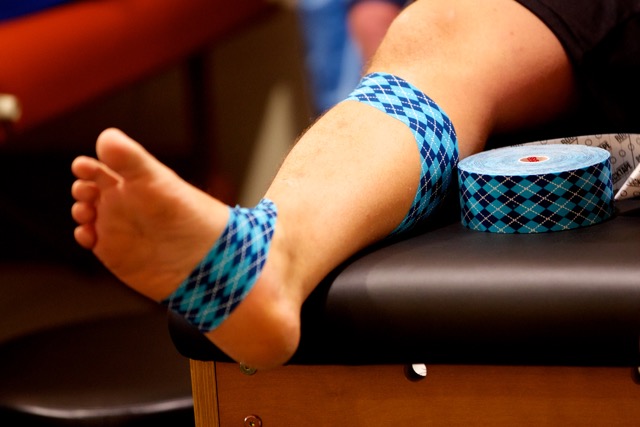We have heard many questions pondered by physicians and healthcare professionals alike. When it comes to the foot there seems to be one that is always on everyone’s mind: To brace the foot, or to not brace the foot? The use of custom foot orthotics has been, and continues to be, a widely prescribed treatment for patients suffering from lower extremity discomfort* as well as a preventative therapeutic intervention. In fact, there are some chiropractic programs who offer complimentary orthotics to all students to “try their product” – but is this a good idea?
If I had a patient come to my office with low back discomfort*, would my first intervention be to recommend a back brace? Would it be an intervention at all? I think the majority would say probably not. Why? Well, as chiropractic physicians, we would be assessing joint function, movement patterns, strength deficits determined to find the root of the problem rather than simply putting a band aid on the patients’ symptoms, i.e. low back brace.
So why then, when our patients come in with foot discomfort*, are we still overly prescribing foot orthotics? The foot and ankle contain 26 bones, 33 joints, and more than 100 muscles, tendons and ligaments. Now if we aren’t assessing function here, and allowing assessment to guide our intervention, we have a problem.
Our bodies were simply not designed to walk on man-made surfaces, nor utilize footwear that suffocates our feet, a concept often referred to as American foot binding. As a result of flat smooth services, cushioned heels and motion control shoes, we have lost the integrity of the foot and ankle complex – leading to intrinsic foot weakness and poor biomechanics. What is more interesting is that new technology is essentially trying to reverse the previous “advancements” in the shoe industry by allowing for our foot to move more naturally. In my opinion we would never want to ‘brace the foot’ unless absolutely necessary. One of the definitions of ‘brace,’ according to Merriam Webster is as follows: “Something that transmits, directs, resists, or supports weight or pressure.” Our feet happen to be one of the most sensory-loaded areas of the human body with over 200,000 nerve endings that were designed to be stimulated, driving information to our brains to produce motor output while allowing us to navigate the multiple terrains and surfaces we encounter everyday on earth. If our feet were in fact designed to transmit, direct, resist and support weight and pressure, why would we want to ‘brace’ them and eliminate their function?
Let’s review the popular diagnosis of plantar fasciitis, one of the most common causes of heel discomfort*. Until recently, it was thought that flat footed individuals, those with a lowering of the medial arch, were prone to overloading the insertion of the plantar fascia. The notion was that due to this increased tension on the heel, there was a predisposition to formations of heel spurs. In 2003, a detailed study in “Skeletal Radiology” looked at 22 heel bones with spurs and refuted this long standing theory. The study revealed that the spurs form at the origin of the flexor digitorum brevis muscle, not the plantar fascia. This emphasizes the importance of the relationship between the intrinsic muscles of the foot and the plantar fascia. The intrinsic muscles of the foot work in conjunction with the plantar fascia at different phases in the gait cycle to prevent excessive lowering of the arch as well as assist in arch elevation. If there is a weakness of the intrinsic muscles of the foot, for example, flexor digitorum brevis, the function of the plantar fascia is compromised.
Other studies have also found that weakness of the posterior tibialis muscle can cause excessive pronation and plantar fascia elongation(1). But it does not simply end at the foot, proximal muscle weakness from gluteus medius, gluteus minimus, and TFL can further lead to poor shock absorption and decreased pronation control(2). The report also sites heel cord tightness in patients with plantar fasciitis. Taking this into account, in the treatment of plantar fasciitis, a conservative approach addressing function should be seriously considered before more drastic measures such as bracing be considered. The utilization of kinesiology tape to stimulate the sensory receptors, soft tissue techniques such as IASTM to improve mobility, and corrective strategies to improve strength and motor control should be considered first and foremost.
Therefore, utilization of custom foot orthotics is only necessary when there is a structural deformity that function cannot override. An example of this would be an excessive forefoot varus which would result in significant dysfunction and discomfort* for patients if not corrected with external assistance. When a custom orthotic is necessary, the lab matters; you should have a quality lab that will work with you to accommodate your patients’ individual needs.
In conclusion, when determining whether to brace or not to brace, utilize your skills as a clinician and determine if what you are assessing is truly a structural deformity that needs assistance, or if this a foot that simply needs assistance functioning better.
Works Cited
1. Thordarson DB, Schmotzer H, Chon J, Peters J. Dynamic support of the human longitudinal arch: a biomechanical evaluation. Clin Orthop. 1995;316:165–172. [PubMed]
2. Sahrmann SA. Diagnosis and Treatment of Movement Impairment Syndromes. St Louis, MO: Mosby; 2002. Movement impairment syndromes at the hip; pp. 121–193.
3. Rome K, Howe T, Haslock I. Risk factors associated with the development of plantar heel discomfort* in athletes. Foot. 2001;11:119–125.O

